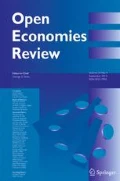Abstract
The currency crisis literature has identified two possible types of crisis: fundamentals based crises and self-fulfilling crises. A fundamentals based crisis arises when some state variable, such as foreign exchange reserves, reaches a critical level and triggers the abandonment of the fixed rate. A self-fulfilling crisis is triggered by an autonomous change in the beliefs of speculators. This paper demonstrates how these two types of crises generate different behaviour in the term structure in the period before the crisis.
Similar content being viewed by others
References
Abramowitz, M. and I.A. Stegun (eds) (1965) Handbook of Mathematical Functions. New York: Dover Publications.
Aghion, P., P. Bacchetta, and A. Banerjee (2001) “Currency Crises and Monetary Policy in a Credit-Constrained Economy.” European Economic Review 45:1121–1150.
Campbell, J.Y. and R.J. Shiller (1991) “Yield Spreads and Interest Rate Movements: A Bird's Eye View.” Review of Economic Studies 58:495–514.
Corsetti, G., P. Pesenti, and N. Roubini (1999) “Paper Tigers? A Model of the Asian Crisis.” European Economic Review 43:1211–1236.
Cox, D.R. and H.D. Miller (1965) The Theory of Stochastic Processes. London: Chapman and Hall.
Dai, Q. and K.J. Singleton (2000) “Specification Analysis of Affine Term Structure Models.” Journal of Finance 55:1943–1978.
Duffie, D. and R. Kan (1996) “A Yield-Factor Model of Interest Rates.” Mathematical Finance 6:379–406.
Flood, R. and N. Marion (1999) “Perspectives on the Recent Currency Crisis Literature.” International Journal of Finance and Economics 4:1–26.
Krugman, P.R. (1979) “A Theory of Balance of Payments Crises.” Journal of Money, Credit and Banking 11:311–325.
Krugman, P.R. (1997) “Are Currency Crises Self-Fulfilling?” NBER Macroeconomics Annual, Cambridge: MIT Press.
Obstfeld, M. (1986) “Rational and Self-Fulfilling Balance of Payments Crises.” American Economic Review 76:72–81.
Obstfeld, M. (1994) “The Logic of Currency Crises.” Banque de France Cahiers Économiques et Monétaires 43:189–213.
Ozkan, F.G. and A. Sutherland (1998) “A Currency Crisis Model with an Optimising Policymaker.” Journal of International Economics 44:339–364.
Svensson, L.E.O. (1991) “The Term Structure of Interest Rate Differentials in a Target Zone: Theory and Swedish Data.” Journal of Monetary Economics 28:87–116.
Author information
Authors and Affiliations
Corresponding author
Additional information
JEL Classification Numbers: E43, F31
Rights and permissions
About this article
Cite this article
Sutherland, A. Currency Crises and the Term Structure of Interest Rates. Open Econ Rev 17, 57–71 (2006). https://doi.org/10.1007/s11079-006-5214-1
Issue Date:
DOI: https://doi.org/10.1007/s11079-006-5214-1




